The above page is from the illustrated supplement of La Nación, published just before All Saints’ Day or Día de los Difuntos (Año II, Nº 61, 29 oct 1903). At the turn of the 20th century, Recoleta Cemetery had yet to become the fabulous outdoor art gallery that it is today… in fact, local critics were harsh & perhaps motivated families to up their game. Translation of the text follows:
Recoleta Cemetery reproduces the city in its layout. It is the same checkerboard, crossed at some points by diagonals, the same, somewhat monotonous structures; the old ones in brick and lime plaster, the new ones with better materials: marble, granite, porphiry, bronze. Thus, the city of the dead was ennobled by contact with the modern spirit, and the tombs evolved in magnificence and solidity, following the same parallel as civil buildings.
There is no grass in Recoleta. Just here and there, a little place for a tree, for a bush, which grow melancholically among surrounding death. Art, which uplifts sentiment toward noble ideals, appears in very few cases in the aristocratic necropolis. Beautiful monuments are still rare, and their number is certainly not in relation to that of the rich owners, nor to the development of good taste, which we sometimes notice in other aspects of our society in Buenos Aires.
For this reason, this year’s chronicle of monuments is very brief. That of D. Carlos Marín Martínez: a crypt with a small chapel superimposed, a simple work of an architect. Two others are to be inaugurated: those of the Canesa and Etchepare families, still half hidden by scaffolding, and therefore unable to be judged.
That of the Semino family was inaugurated a few months ago. It is a mythological version of Time, a humanized Saturn, in white Carrara marble waiting near a door, which rests on a piece of black marble. The robust, muscular build of the old man was modeled with vigor and skill by Mr. Fabiani.
Among the crypts, that of Dr. José C. Paz, with very few and severe lines framing a bronze door, is of good conception, built as if to destroy the centuries, and yet, not lacking in sober elegance.
But the great funerary monument of the year is the one that Ricardo Aigner has sculpted in memory of Miss Rufina Cambaceres.
It seems impossible that Mr. Aigner is the author of a bas-relief, belonging to a monument that is not worth mentioning, and whose mediocrity he would like us to forget. But in this one, the artist has spread his wings. Our photograph can barely give an idea of the soft elegance of that girl’s figure, wearing a tunic whose folds fall like tears, and who with a melancholic face turns a last glance towards this world, in which, alas! she lived for such a short time… The art nouveau style of the work with its interlacing of tall and flexible stems, and the fantastic flowers that crown it, do not detract from the tomb of a girl, and constitute a happy daring. Certain disproportions in the figure —perhaps actually existing— disappear before the harmony of the whole, before the intense expression of profound and yet resigned and gentle sadness that emanates from its features. And the observer, upon leaving this tomb, carries for a long time in his soul the impression of that extreme farewell.
This brief text brings up many points to consider…
- The comparison of the cemetery to a miniature city had already been established almost 125 years ago.
- Apparently La Nación evaluated new additions to the cemetery in previous years, but I haven’t found earlier issues online. Yet.
- Genoan sculptor Federico Fabiani established himself as a master of funerary art with other works in Caracas & in the city of Rosario. I wonder how the Semino family heard of him, & more importantly, where did that gorgeous statue end up? The tomb of boxer Luis Ángel Firpo now sits where José Semino placed the sculpture of Father Time/Saturn.
- The brilliant 1904 sculpture by Jules Felix Coutan on the José C. Paz tomb had yet to be added when this article appeared. Was it in the works already, or did this criticism spur a fancy addition?
- What mediocre bas-relief by Richard Aigner does the author refer to? The only other work by Aigner in Buenos Aires I can find is a statue of Germán Burmeister commissioned many years later in 1929. Any ideas?
The next edition of the supplement (Año II, Nº 62, 05 nov 1903) shows the festivities for All Saints’ Day. Traditions have certainly changed because no one decorates their family mausoleum like this nowadays. A procession of Santa María del Socorro (from nearby Retiro) even took place inside the cemetery!
This post serves as a perfect example of why we’ve researched Recoleta Cemetery for almost 20 years: there’s always something interesting to uncover… which often leads to even more questions!
Update (04 Jul 2025): Marcelo found another group of images depicting All Saints’ Day —the last two are of Recoleta Cemetery— in the Buenos Aires society magazine Caras y Caretas from 10 Nov 1906:
Magazine text & images were scanned by Google Books. Postcard photograph of the José Semino mausoleum by Harry Grant Olds, listed in Centro de Investigación Fotográfico Histórico Argentino. Both in public domain.
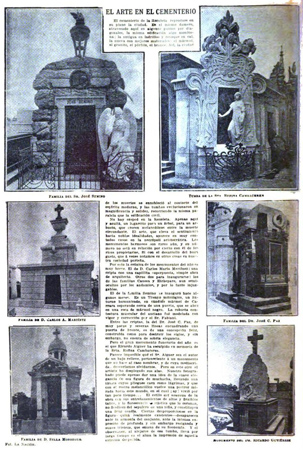
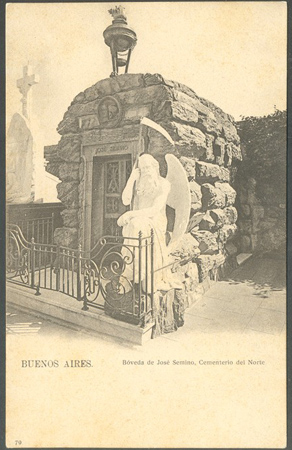
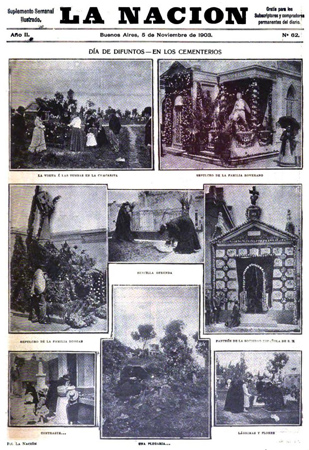
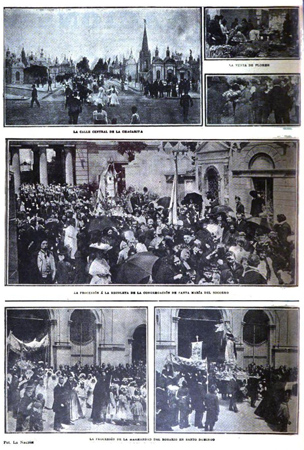
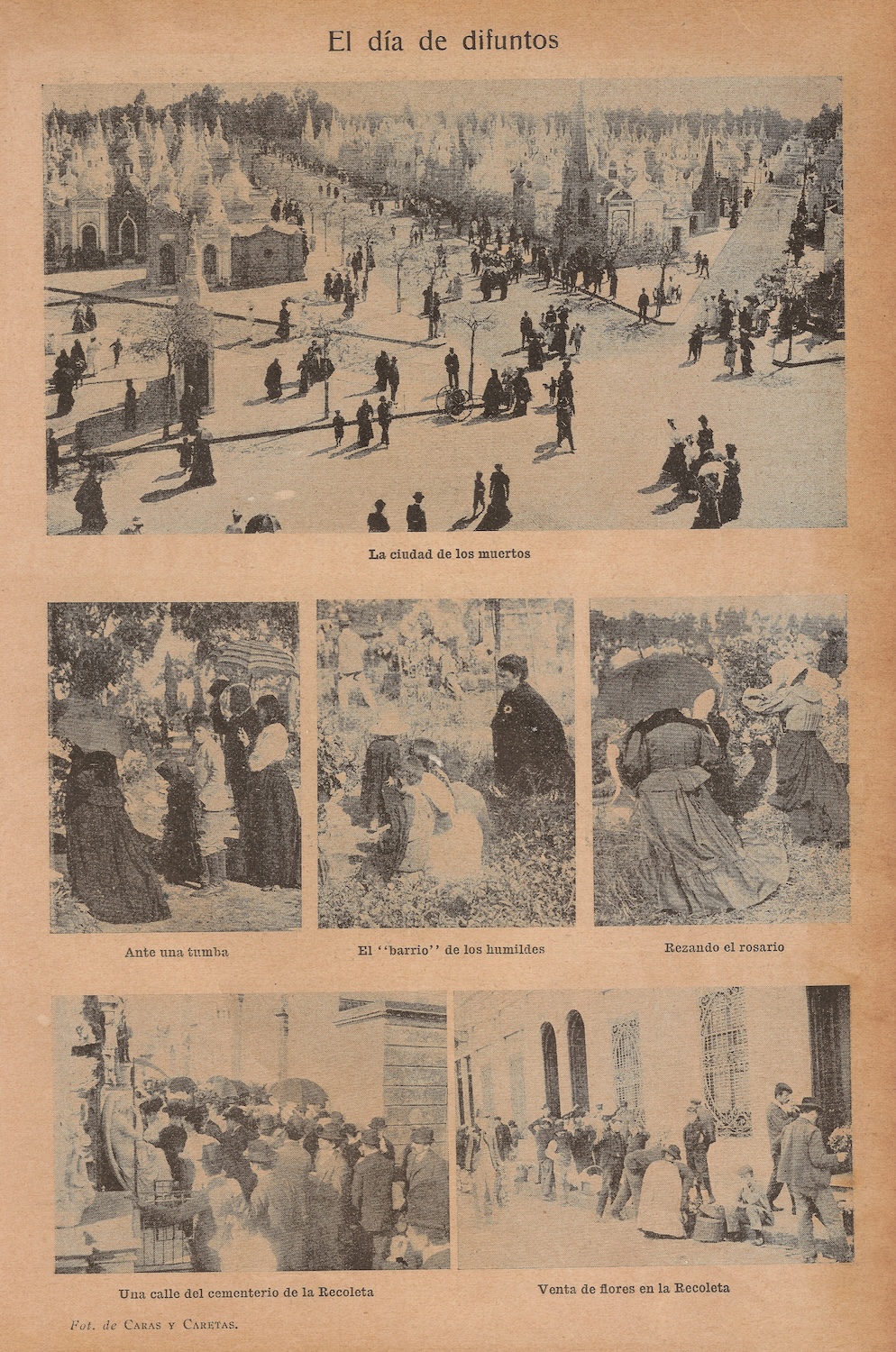
Be First to Comment